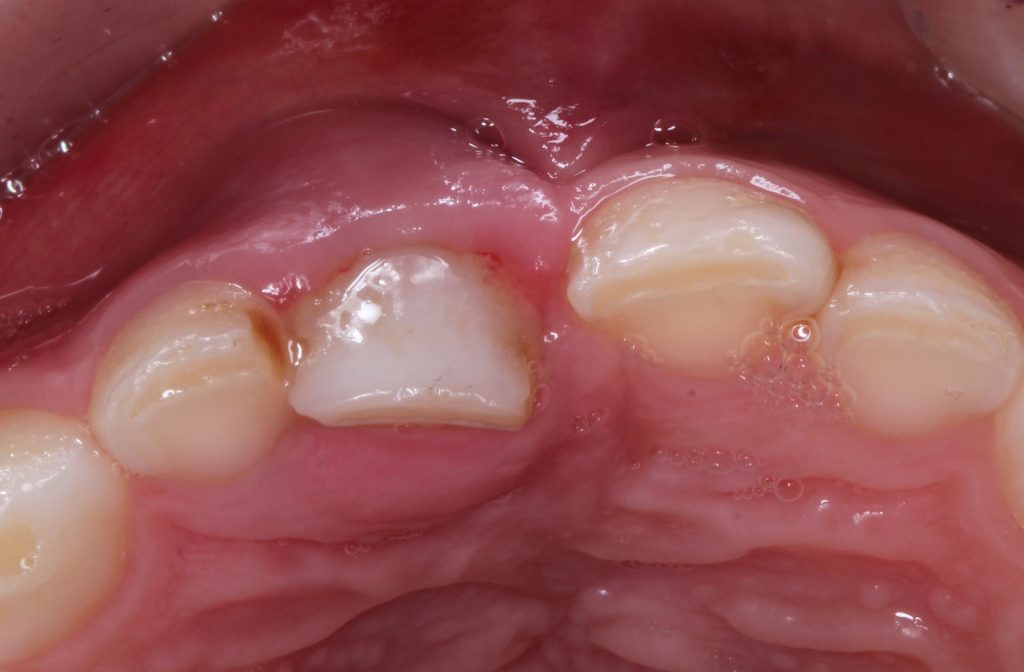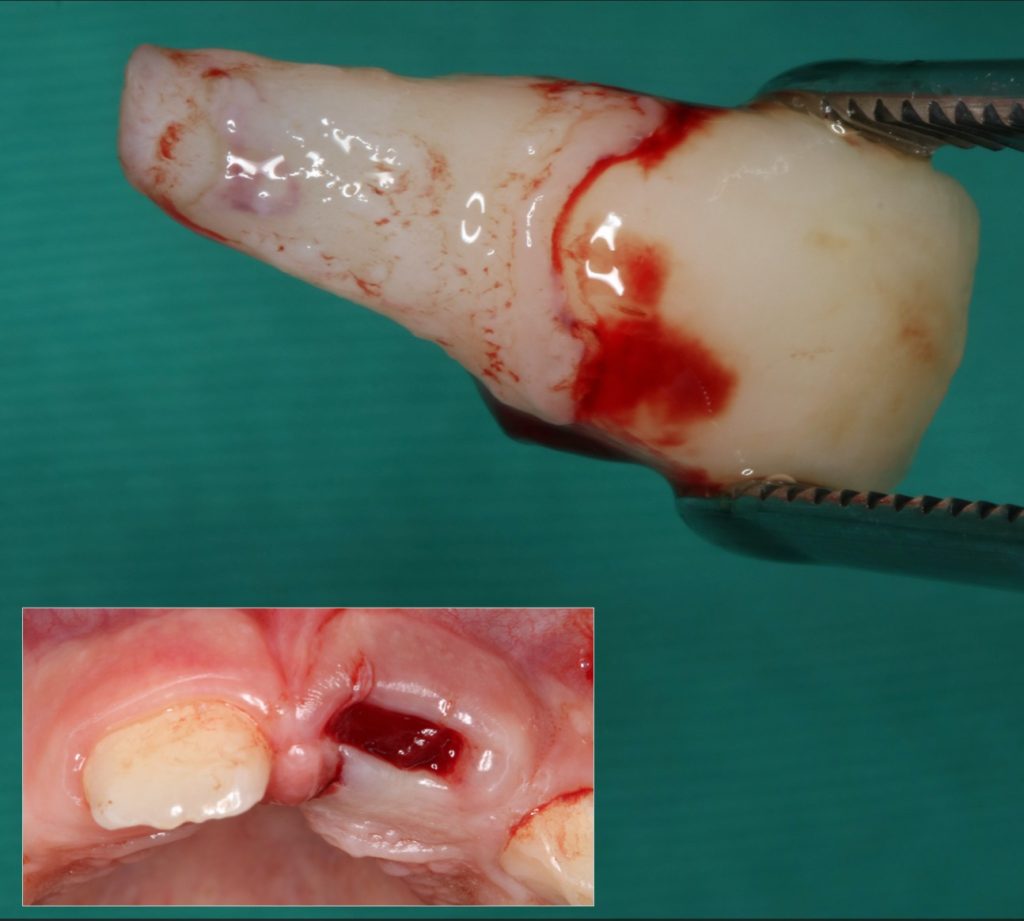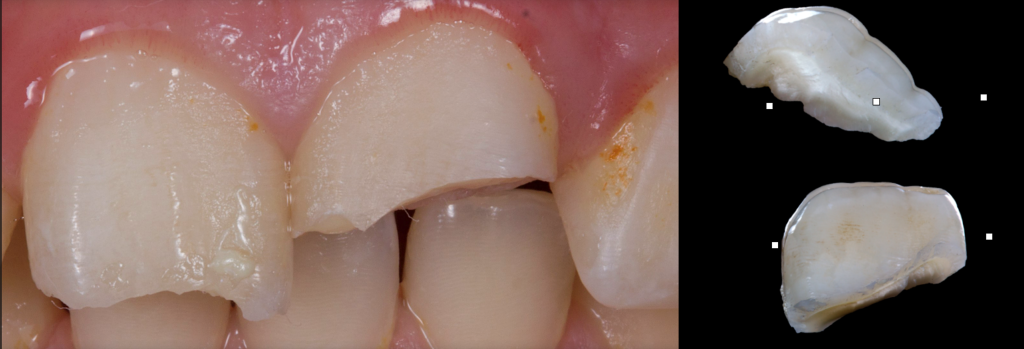
Image: Dr. Zafer Cehreli
What should you know about dental injuries of primary teeth?
1. When the child first starts exploring the world by themselves, with the help of their first baby walker, they are exposed to falls that can affect their face and teeth.
2. During the first years of life, the primary teeth are very closely related to the permanent teeth, which are forming inside the bone.
3. When injury occurs to the primary teeth in this period, it can affect the aesthetics of the permanent teeth, which will present at approximately eight years of age with whitish marks or a deformation in the crown depending on the extent of the injury.
4. The most serious lesions on the primary teeth can cause complications to the permanent successors; ie. intrusion (when the tooth is buried in the gum) and avulsion (when the tooth is knocked out). Both situations are more serious the younger the child is. The primary tooth should not be replaced once it has been knocked out.

Image: Dr. Zafer Cehreli
How to prevent dental trauma in primary teeth?
1. Do not use baby walkers.
2. Do not let children use roller skates without protection.
3. Teach your children to:
a. Look after their teeth as well as that of their friends’ teeth when playing by not knocking their teeth with heavy objects.
b. Watch out for possible obstructions that they can trip themselves up on.
c. Do not push when playing.
d. Stay seated on the swing and do not jump off when the swing is in motion.
e. Use the stairs when getting out of the swimming pool.
4.If the child participates in sports such as rugby, hockey, karate, riding on a bike, wintersports (i.e. skiing) a skate board or any activity that involves potential trauma to the facial area, make sure that the child uses a helmet or mouth protector

Image: Dr. Zafer Cehreli
What to do in case of a fall that affects a permanent teeth?
1. First, you must consult a dentist immediately after the accident has occurred. This measure has many advantages:
a. There is more possibility of conserving the tooth’s vitality.
b. A conservation treatment will be applied.
c. There is a better prognosis.
d. Future complications and high-cost treatments are prevented.
2. It is of vital importance that all traumatic injuries are diagnosed, treated, and controlled in time (at least within five years).

Image: Dr. Zafer Cehreli
What to do if a permanent tooth falls out?
1. Find the tooth. Hold the tooth by the crown (the white part), not by the root (the yellow part).
2. Replant immediately, if possible.
3. If dirty, rinse shortly with water and put the tooth back in its place. This can be done by the child or an adult.
4. Hold the tooth in place. Bite on a handkerchief to hold it in position and go to the dentist immediately.
5. If you cannot put the tooth back in, place it in a cup of milk or saline. When milk or saline are not available, place the tooth in the child’s mouth (between the cheeks and gums)
6. Seek immediately specialized dental treatment.
7. Children between 7 and 10 years of age are more exposed to suffer avulsion due to the elasticity of the bone at this age.
8. Good oral hygiene is absolutely necessary in the healing period


Image: Dr. Zafer Cehreli
What to do if a permanent tooth is broken?
1.This is not an emergency, but definitely needs treatment.
2.Try to find the broken piece and store it in milk or water (do not keep dry).
3.Your dentist may be able to glue it back on.
Prevention and Emergency Care >Resources
- Traumatic dental injuries can occur in all age groups but are more commonly seen in children and young adults.
- Risk factors include age, behavior, forwardly placed front teeth and environment such as slippery floors or not wearing protective gear while playing.
- Awareness on how to avoid them and what to do if an injury occurs are therefore very important.
Link to publication : https://onlinelibrary.wiley.com
- Primary prevention means preventing first injury.
- This includes educating patients and various stakeholders, providing preventive care by recognizing the risks and treating them and by offering guidance on the use of various safety devices and measures.
- Modification of the environment especially for the very young and very old is of paramount importance including safety equipment such as stairgates, window guards, mobility assistance, removal of loose mats/flooring etc.
Link to publication : https://onlinelibrary.wiley.com/doi/epdf/10.1111/edt.12924?domain=p2p_domain&token=3VQDH2HURZGMY3K9DB4W
- Individuals participating in various sports activities are at a potentially increased risk of injury to their teeth and mouths.
- Many injuries can be prevented with the use of a mouthguard.
- Mouthguards have been proven to be effective in preventing dental injuries and are recommended for use in many sports that have an increased risk of dental injury.
Link to publication :
- Face shields or facemasks are recommended to prevent injuries to the face and mouth.
- They can also be used as a protective device while recovering from an injury.
- Face shields can reduce injuries to the teeth, mouth, eyes, nose and bones of the face.
- Face shields are effective in reducing dental injuries in various sports.
Link to publication :https://onlinelibrary.wiley.com/doi/epdf/10.1111/edt.12926?domain=p2p_domain&token=Q5FNTNPJSHWAM66H8HRC
- Secondary prevention means preventing further injuries to the same tooth/teeth.
- This is important since teeth which have been previously traumatized are vulnerable to further injury which may lead to unsuccessful long-term outcomes, even if they were successfully treated after the first injury.
- Education of everybody potentially associated with traumatic dental injuries—such as the injured individual, parents / family/ caregivers, schoolteachers, sports persons and coaches, and non-dental health care professionals—regarding the prevention and emergency management of dental injuries is essential.
- Dental professionals must be empowered and motivated to disseminate this information to help prevent TDI globally.
- The essential areas of education that should be addressed are:
- Dental / specialist check for conditions that make an individual more prone to dental trauma.
- It is important for dentists to advise patients and their parents about the risk factors associated with some malocclusions.
- The vast majority of traumatic dental injuries occur in the maxillary anterior (upper front) teeth in young girls and boys.
- Two major factors that increase the risk of such injuries are an increased overjet (protruding upper teeth) and lip incompetence (lips do not close easily).
- Children with other conditions such as severe underbite, open bites, and cross bites are also more susceptible to traumatic dental injuries.
- Consideration of these predisposing factors leads to the obvious question of whether orthodontic intervention for people with these conditions will help to prevent injuries to their teeth.
Link to publication: https://onlinelibrary.wiley.com/doi/epdf/10.1111/edt.12927
- The International Association of Dental Traumatology (IADT) released the ToothSOS app in 2018.
- The aim of this app is to educate the general public, patients, athletes, coaches, athletic trainers, parents, teachers, and dental and medical professionals about traumatic dental injuries.
- The app provides free access for dentist and no dentist about emergency and non-emergency situation in traumatic injuries.

Link to publication:
- Primary prevention that dentist should provide includes education of sport participants, parents, coaches and care givers about the risks of traumatic dental injuries. Can be done at dental clinics, hospitals schools and community organizations or online.
- Dentists should provide preventive care by recognizing the risks and treating them, as well as by offering guidance on the use of protective devices and safety equipment (such as mouth guards).
- Dentists should be available to provide treatment, video or telephone consultations in emergency situations.
Link to publication: https://onlinelibrary.wiley.com/share/BEYVCHZDV9RTI83DDDBG%3Ftarget%3D10.1111/edt.12930&ust=1718389680000000&usg=AOvVaw2xcDopYOerNvvfpCTIxazB&hl=en&source=gmail
